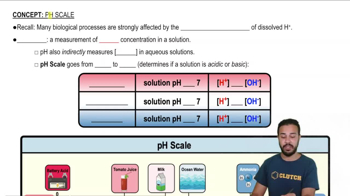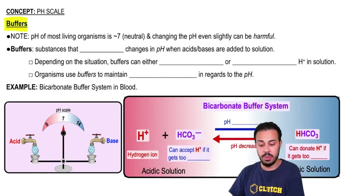Table of contents
- 1. Introduction to Biology2h 42m
- 2. Chemistry3h 40m
- 3. Water1h 26m
- 4. Biomolecules2h 23m
- 5. Cell Components2h 26m
- 6. The Membrane2h 31m
- 7. Energy and Metabolism2h 0m
- 8. Respiration2h 40m
- 9. Photosynthesis2h 49m
- 10. Cell Signaling59m
- 11. Cell Division2h 47m
- 12. Meiosis2h 0m
- 13. Mendelian Genetics4h 44m
- Introduction to Mendel's Experiments7m
- Genotype vs. Phenotype17m
- Punnett Squares13m
- Mendel's Experiments26m
- Mendel's Laws18m
- Monohybrid Crosses19m
- Test Crosses14m
- Dihybrid Crosses20m
- Punnett Square Probability26m
- Incomplete Dominance vs. Codominance20m
- Epistasis7m
- Non-Mendelian Genetics12m
- Pedigrees6m
- Autosomal Inheritance21m
- Sex-Linked Inheritance43m
- X-Inactivation9m
- 14. DNA Synthesis2h 27m
- 15. Gene Expression3h 20m
- 16. Regulation of Expression3h 31m
- Introduction to Regulation of Gene Expression13m
- Prokaryotic Gene Regulation via Operons27m
- The Lac Operon21m
- Glucose's Impact on Lac Operon25m
- The Trp Operon20m
- Review of the Lac Operon & Trp Operon11m
- Introduction to Eukaryotic Gene Regulation9m
- Eukaryotic Chromatin Modifications16m
- Eukaryotic Transcriptional Control22m
- Eukaryotic Post-Transcriptional Regulation28m
- Eukaryotic Post-Translational Regulation13m
- 17. Viruses37m
- 18. Biotechnology2h 58m
- 19. Genomics17m
- 20. Development1h 5m
- 21. Evolution3h 1m
- 22. Evolution of Populations3h 52m
- 23. Speciation1h 37m
- 24. History of Life on Earth2h 6m
- 25. Phylogeny2h 31m
- 26. Prokaryotes4h 59m
- 27. Protists1h 12m
- 28. Plants1h 22m
- 29. Fungi36m
- 30. Overview of Animals34m
- 31. Invertebrates1h 2m
- 32. Vertebrates50m
- 33. Plant Anatomy1h 3m
- 34. Vascular Plant Transport1h 2m
- 35. Soil37m
- 36. Plant Reproduction47m
- 37. Plant Sensation and Response1h 9m
- 38. Animal Form and Function1h 19m
- 39. Digestive System1h 10m
- 40. Circulatory System1h 57m
- 41. Immune System1h 12m
- 42. Osmoregulation and Excretion50m
- 43. Endocrine System1h 4m
- 44. Animal Reproduction1h 2m
- 45. Nervous System1h 55m
- 46. Sensory Systems46m
- 47. Muscle Systems23m
- 48. Ecology3h 11m
- Introduction to Ecology20m
- Biogeography14m
- Earth's Climate Patterns50m
- Introduction to Terrestrial Biomes10m
- Terrestrial Biomes: Near Equator13m
- Terrestrial Biomes: Temperate Regions10m
- Terrestrial Biomes: Northern Regions15m
- Introduction to Aquatic Biomes27m
- Freshwater Aquatic Biomes14m
- Marine Aquatic Biomes13m
- 49. Animal Behavior28m
- 50. Population Ecology3h 41m
- Introduction to Population Ecology28m
- Population Sampling Methods23m
- Life History12m
- Population Demography17m
- Factors Limiting Population Growth14m
- Introduction to Population Growth Models22m
- Linear Population Growth6m
- Exponential Population Growth29m
- Logistic Population Growth32m
- r/K Selection10m
- The Human Population22m
- 51. Community Ecology2h 46m
- Introduction to Community Ecology2m
- Introduction to Community Interactions9m
- Community Interactions: Competition (-/-)38m
- Community Interactions: Exploitation (+/-)23m
- Community Interactions: Mutualism (+/+) & Commensalism (+/0)9m
- Community Structure35m
- Community Dynamics26m
- Geographic Impact on Communities21m
- 52. Ecosystems2h 36m
- 53. Conservation Biology24m
3. Water
pH Scale
Problem 7`
Textbook Question
A can of cola consists mostly of sugar dissolved in water, with some carbon dioxide gas that makes it fizzy and makes the pH less than 7. In chemical terms, you could say that cola is an aqueous solution where water is the _________ , sugar is a _________ , and carbon dioxide makes the solution _________ . a. solvent . . . solute . . . basic b. solute . . . solvent . . . basic c. solvent . . . solute . . . acidic d. solute . . . solvent . . . acidic
 Verified step by step guidance
Verified step by step guidance1
Step 1: Understand the concept of an aqueous solution. An aqueous solution is a mixture where water acts as the solvent, meaning it is the substance in which other materials are dissolved.
Step 2: Identify the role of sugar in the cola. Sugar is dissolved in water, making it the solute, which is the substance being dissolved in the solvent.
Step 3: Analyze the role of carbon dioxide in the cola. Carbon dioxide gas dissolves in water and forms carbonic acid, which lowers the pH of the solution, making it acidic (pH less than 7).
Step 4: Match the terms 'solvent,' 'solute,' and 'acidic' to their respective roles in the cola. Water is the solvent, sugar is the solute, and carbon dioxide makes the solution acidic.
Step 5: Review the answer choices and select the one that correctly matches the roles: solvent (water), solute (sugar), and acidic (carbon dioxide).
 Verified video answer for a similar problem:
Verified video answer for a similar problem:This video solution was recommended by our tutors as helpful for the problem above
Video duration:
1mPlay a video:
Was this helpful?
Key Concepts
Here are the essential concepts you must grasp in order to answer the question correctly.
Aqueous Solution
An aqueous solution is a solution in which water is the solvent. In this context, the solvent is the substance that dissolves the solute, allowing for the formation of a homogeneous mixture. For example, in a can of cola, water serves as the medium that dissolves sugar and carbon dioxide, creating the fizzy drink we consume.
Recommended video:
Guided course

Homogenous vs. Heterogenous Solutions
Solute and Solvent
In a solution, the solute is the substance that is dissolved, while the solvent is the substance that does the dissolving. In cola, sugar is the solute because it is the component that dissolves in water, the solvent. Understanding the roles of solute and solvent is crucial for identifying the components of any solution.
Recommended video:
Guided course

Properties of Water- The Universal Solvent
pH and Acidity
pH is a measure of the acidity or basicity of a solution, with values below 7 indicating acidity. In the case of cola, the presence of carbon dioxide contributes to its acidic nature, as it forms carbonic acid when dissolved in water. Recognizing the relationship between pH and the components of a solution helps in understanding the overall chemical properties of substances like cola.
Recommended video:
Guided course

pH Scale
Related Videos
Related Practice










